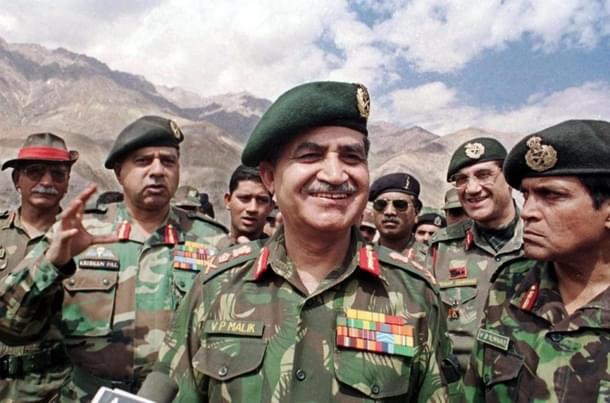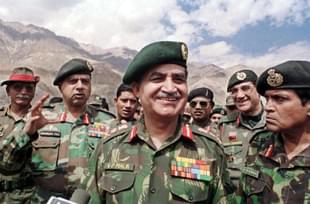Defence
Three Lessons Not Learnt Even After 25 Years Of Kargil War
Ujjwal Shrotryia
Jul 26, 2024, 05:07 PM | Updated 06:36 PM IST
Save & read from anywhere!
Bookmark stories for easy access on any device or the Swarajya app.


This day, 26 July, marks 25 years of the triumph of the Indian Army over the Pakistan Army in Kargil.
After being surprised and sustaining significant casualties in the initial days of the war and realizing that the infiltrators were actually Pakistani Army regulars dressed as terrorists, the army pushed with all its might and threw the Pakistani's out of the mountains.
When the war ended, more than 527 soldiers and officers had lost their lives capturing the towering heights of Kargil that averaged more than 15,000 feet.
This was even more embarrassing when it was learned that while Indian Prime Minister Atal Bihari Vajpayee was in Pakistan in February 1999, Pakistan Army regulars were climbing the peaks of Kargil.
A review committee, named the Kargil Review Committee, under the chairmanship of K. Subrahmanyam, father of current External Affairs Minister S. Jaishankar, was formed to identify how India was caught unawares.
The committee came out with multiple recommendations to be implemented in the Armed Forces and in the higher command structure to prevent a repeat of Kargil.
However, even after 25 years, some lessons that ought to be learned by the forces are still not learned. Here we list three of them.
(1) Jointmanship
The first and foremost lesson of the Kargil Review Committee was an increase in jointmanship between the three armed forces, meaning joint planning and execution. This includes the formation of a post of Chief of Defence Staff (CDS) and the creation of Integrated Theatre Commands (ITC).
It has been more than 25 years, but even now India is nowhere on this count.
The government and the forces have shown apathy and a lack of enthusiasm towards this. On the part of the government, it took close to 20 years to appoint a CDS, with the first CDS, General Bipin Rawat, only appointed in 2019.
When the CDS died in an unfortunate crash, the government again took a sweet time of a year to announce his replacement — General Anil Chauhan.
And, on the part of the Armed Forces, extensive bickering over who will control whose assets, and who will get how many command appointments, etc, has delayed its implementation extensively.
The Indian Air Force’s reluctance to part with its already dwindling air assets to the future theatre commanders is a case in point.
It’s only just two months ago, in late May, days before the new government won the elections, that it instructed the armed forces to implement within a year of the new government swearing in.
This is when a severe lack of jointness and planning was one of the primary reasons identified for the Russians not making meaningful progress in the early stages of the Russia-Ukraine war.
The Russian Air Force and Artillery were nowhere to be seen in the early stages of the war in the race towards Kyiv, which cost them the war that has now come to a stalemate.
India suffers the same risks if it goes to war with a much larger, more technologically advanced Chinese People Liberation Army (PLA) in the Himalayas.
(2) Artillery
Another reason that gave the army rich dividends in throwing out the Pakistani's was artillery.
When the Indian soldiers rushed to the mountains to remove intrusions in the early days of the war without adequate preparation and artillery support, they got beaten back with heavy casualties.
It was when the extent of the intrusion was discovered and the army inducted medium-calibre Swedish Bofors 155mm howitzers into the theatre that the tide started to turn. Most devastating was the direct fire that the Bofors guns inflicted on the Pakistanis, which blew up their makeshift stone hideouts, called Sangars.
On the day Tiger Hill fell, close to almost 10,000 shells were fired.
Various Pakistani accounts say that the Indian artillery was the most deadly, which wilted the will of the Pakistani soldier to stand their ground and fight the war.
This is again demonstrated in the Russia-Ukraine war where Ukrainians are complaining about the lack of artillery in their inventory and the Russian Army’s overwhelming artillery superiority.
At its peak, the Russian Army fired close to 40,000 to 50,000 shells a day while the Ukrainians could only do 10,000 to 15,000. The majority of the casualties are due to artillery.
Even after realizing the importance, 25 years after Kargil and now in the Russia-Ukraine war, it does not seem that the correct lessons have been learned.
Even now, no large artillery orders have been given by the army. And that is when the Indian industry, both private and public-owned, has achieved self-sufficiency in designing and manufacturing artillery guns.
In fact, these guns are finding success in the export market as well.
Case in point: Armenia buying Advanced Towed Artillery Guns (ATAGS) from Kalyani Strategic Systems Limited (KSSL) while the army is still balking on giving initial orders of ATAGS.
The only two worthwhile orders are the direct import of ultra-light M-777 howitzers from the United States and the joint production of K-9 Vajra-T tracked howitzers in India with the help of South Korea.
There seems to be no movement forward in the buying of further tracked howitzers and wheeled self-propelled ones, either.
(3) Intelligence
When the initial reports of Indian casualties started arriving from Kargil, it was thought that it was Pakistan-supported terrorists.
It was only learned sometime in the end of May or early June that it was not irregulars but serving Pakistan Army soldiers sitting on top of the heights.
The entire nation shook and asked how the Pakistanis reached those heights and dug themselves in when PM Vajpayee had recently been to Lahore and extended a hand of friendship towards Pakistan.
The question was asked: how come Indian intelligence did not get a whiff of such large-scale intrusions?
Again, it seems, the correct lessons were not learned because 21 years later (in 2020), India suffered a similar setback with China, where Chinese soldiers, after their regular exercises, did not return to their peacetime positions and converged at the Indian border, which caused multiple skirmishes at Pangong Tso lake, culminating in the clash at Galwan which left 20 Indian soldiers dead, surprising the entire nation.
It was only after the valiant efforts of soldiers in Operation Snow Leopard that India was able to push the Chinese back from some forward positions and bring them to the table.
Why is it that the strategic Indian intelligence, whose job is to keep a keen eye over Pakistan and China to try to predict any misadventure, gets surprised?
Whether any corrective measures were taken after this debacle is not known.
Staff Writer at Swarajya. Writes on Indian Military and Defence.





